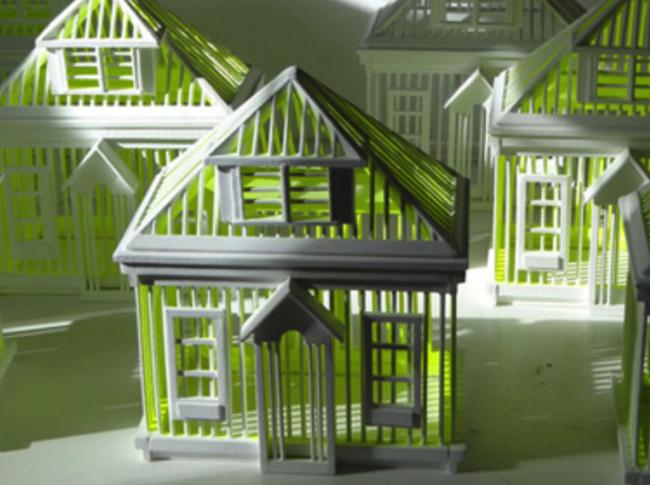At Large in Ballard: The House of Macefield
Photo courtesy of Laurence Landois.
Wed, 05/14/2014
By Peggy Studivant
I drive past the house near the Ballard Bridge where Edith Macefield lived until her death almost every day, but I haven’t really looked at it in years. I remember her blue car parked in front, the one just like my father’s. Sometimes I would see Edith Macefield picking blackberries along the fence that separated her house from the garbage truck lot. She looked like my grandmother. I wanted to ask what it was like to live in a place that had gone from residential to industrial. Why she stayed?
The 1900 house is boarded up now, obscured on three tall sides by Ballard Blocks. She wouldn’t sell developers the 1550 square feet that included her lifelong home. The story of a woman rejecting a million dollar offer drew national media. At the age of 83 she was adopted as a poster child for resisting development, anti-greed, co-opted for a cause, wily enough to know it.
There is a documentary, a music festival, Macefield tattoos and a book written by the construction company superintendent who became her sole heir in 2008. Pixar launched balloons there as a movie tie-in. “What’s Your Credo?” reads a sign on the fence, a clue to the present owner and their alleged plans to raise the house toward the sky as a vacation rental.
Across the street another ugly fence encloses what was supposed to be Phase II of Ballard Blocks. The entire block is filled with dubious water, a Waste Management container marooned in the middle. In winter it freezes.
Ballard Blocks dwarfs the northeast end of the Ballard Bridge, but it’s always the vacant lot that I notice. I haven’t really looked at the house in years, not until last week when I met French artist Laurence Landois.
Begun as a response to the collapse of the Twin Towers, Landois has been working on a series of art installations called “Monuments,” turning the detritus of cataclysmic events into commemorative art. Her second installation was in Japan, sharing pieces that suggested cities rising from the disasters of the Tohoku earthquake and Fukushima. Her third installation, on display in a ROOM104 Gallery in Pioneer Square is another monument, or tribute – to Edith Macefield and her house.
Landois lives, works and teaches art in Nantes, which is coincidentally Seattle’s “Sister City” in France. She was first in Seattle two years ago, as part of the “Elle” exhibit at Seattle Art Museum. While exploring galleries she happened to ask Room104 Director Laurie LeClair, ““Would you show the work of an artist from France?” Intrigued by Seattle’s architecture, from Space Needle to Central Library, she was also struck by the story and images of what “La Maison de Macefield.”
Over the last two years Landois has been working on her Edith tribute, called “On The Way.” The installation features ten wooden houses, open like birdcages, painted in Edith’s kitchen yellow. They are suspended from the gallery ceiling, string catching the wind like kite tails. The second part of the exhibit is eleven exquisite ink drawings on graph paper, reimagining the architectural bones of the house in various scenarios. Stacked into a pagoda shape, or what’s termed a “nail house” for the owners that developers find “stubborn as nails” to remove. In another drawing what was Macefield’s “castle” is almost hidden in the spire of castles of the world.

One of three pieces from the "Home Sweet Home" series by Laurence Landois.
Landois drew each one by hand, working on them like embroidery, without a ruler or a plan. In almost every drawing the image of the Macefield house is dwarfed by its environment, but never invisible.
Before visiting the gallery I struggled with my sense that the subject wasn’t worthy of a monument. Macefield had pancreatic cancer. The money was of no use or importance to her at that stage. She just wanted to live in her own home until her death.
Landois made time near the end of her visit to walk me through the exhibit and explain in very good English what she wanted to convey. “The French think the Americans all love money,” Landois said. “This woman interested me.”

One of three pieces from the "Home Sweet Home" series by Laurence Landois.
“She was résistante,” Laurence said, “I am this way too.” As in English the word in French has shades of meaning. I think Landois was saying they were both stubborn and willing to fight back when it came to living their lives a certain way. “I don’t live like many other people.”
A few days ago Landois took the #40 to Ballard to see the house for the very first time. She was happy to finally be there but also disappointed. “I was sad when I see this house,” Landois said. “She was alone.”
America is known throughout the world for its skyscrapers, a bigger is better mentality. The story of the small woman in the small house struck an Internet nerve and one that became personal for the French artist. “I would like to give this woman thanks,” Landois said of Macefield. “She touched me deeply. Her actions produce…inspire creativity.”
The ten houses swayed in the afternoon light. I was wrong to seek a true or false in the Macefield story. Landois has been inspired to art by Macefields actions, and created art that transcends knowledge of the original story.
On the way home I went by the house and really looked at it again while hearing Landois’ words in my head. “An artist can fight too.”
Room104Gallery.com, 306 S. Washington. Open W-S, 10:30-5 pm, and by appointment. “On the Way” on display through May 31.
Contact Peggy atlargeinballard@peggysturdivant.com.


